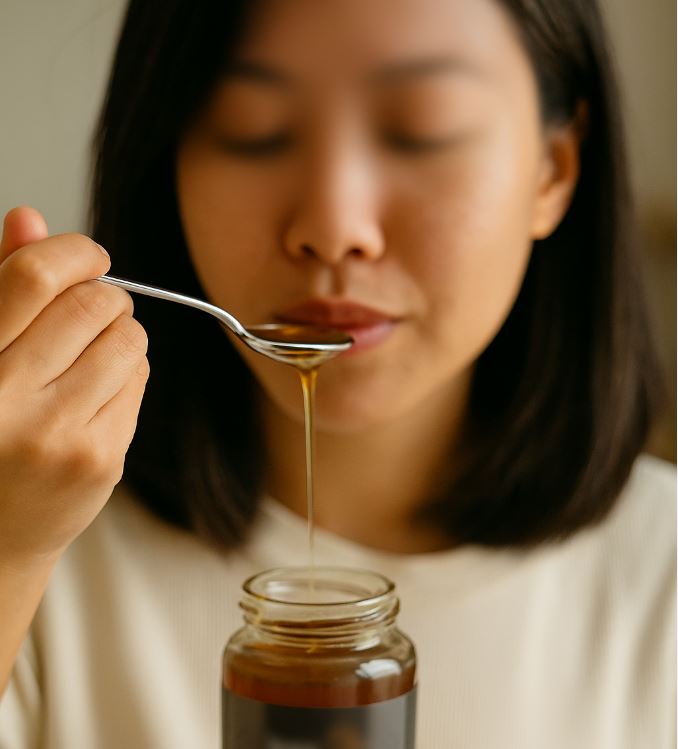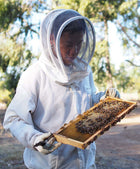How to Find Good Honey in Singapore – A Local Buyer’s Guide

Many Singaporeans love honey for its taste and health benefits, but not all honey on the shelf is equal. With concerns about fake or adulterated honey on the rise, knowing how to choose a good honey in Singapore has become important. In this guide, we’ll explore what makes honey “good,” how to avoid common honey pitfalls, and where you can find pure, raw honey you can truly trust.
What Makes a Honey “Good” or Pure?
A good honey is one that’s pure, unadulterated, and raw. Pure honey means nothing has been added or diluted – it’s the real deal straight from the bees. Unfortunately, honey is one of the world’s most adulterated foods. Unscrupulous producers may mix in cheap sugar syrups or other fillers, so that jar labeled “100% honey” might be far from it. This matters because fake honey lacks the nutrients, enzymes, and beneficial compounds that give real honey its value – you’re essentially paying for flavored sugar water.
How can you tell if honey is pure? One clue is crystallisation: raw, pure honey often crystallises (turns a bit cloudy or grainy) over time, whereas heavily processed or syrup-laden honey tends to remain ultra-clear and liquid. Authentic honey also carries the floral aroma and complex taste of the flowers the bees visited, instead of just one-note sugary sweetness. Transparency in labeling is key as well – trustworthy brands clearly state the honey’s origin (e.g. specific country or region) and type of flowers. If a label only says “Packed in Singapore” without details of where the honey actually comes from, that’s a red flag.
How to Choose Good Honey in Singapore
Choosing good honey in Singapore starts with being a smart honey buyer. First, be aware of the adulteration issue locally. A recent investigation showed that even some premium supermarket honeys labeled as “pure” were secretly part sugar syrup. In fact, a scientific study found 52% of Asian honey samples to be fake – a startling statistic that urges caution. Here are some tips to ensure you get the real thing:
-
Buy from Reputable Sources: Instead of grabbing random honey off the supermarket shelf, consider purchasing from specialty stores or trusted local producers. Experts advise that buying directly from local beekeepers or established health stores can reduce the risk of adulteration. When you can trace the honey’s source, you’re more likely to get genuine honey. (For example, Singapore’s own Bee Bee Natural offers honey harvested straight from its founder’s Western Australian beehives – no middlemen or mystery blends.)
-
Look for Raw or Unprocessed Labels: In Singapore’s humid climate, many commercial honeys are processed for a smoother look, but raw honey is worth seeking out. Raw honey means it hasn’t been heat-pasteurised or finely filtered. This is important because pasteurisation, while extending shelf life, destroys many of honey’s beneficial nutrients and enzymes. Raw honey retains its natural goodness – from pollen traces to antioxidants – so you get all the health benefits. When shopping, check labels or product info for words like “raw,” “unpasteurised,” or “cold-filtered.”
-
Check for Lab Tests or Quality Certifications: High-quality honey brands often send their honey for independent lab testing. These tests can check that no sugar has been added and measure aspects like antibacterial activity. In New Zealand, Manuka honey has the UMF/MGO ratings; similarly, some Australian honeys use a Total Activity (TA) rating to show antibacterial strength. If a brand shares test results or quality seals, it’s a good sign. For instance, Bee Bee Natural’s signature Jarrah honey is lab-certified with a high TA rating, indicating exceptional purity and potency (you can even see the test certification on our Jarrah honey product page). A brand confident enough to publish its lab results is likely selling the real stuff.
-
Be Wary of Bargain Prices: We all love a good deal, but honey that is dramatically cheaper than competitors should raise eyebrows. Pure, authentic honey is costly to produce – bees need to visit millions of flowers to make a single jar! If you see a large jar of “premium” honey going for a price that seems too good to be true, it probably is. It might be diluted or artificial. In Singapore, genuine wild or monofloral honeys (like Manuka, Jarrah, etc.) are priced higher for a reason. It’s better to pay a fair price for real honey than to save a few dollars on sugar syrup.
-
Trust Your Taste Buds and Texture: Finally, let your senses guide you. Good honey has unique aroma, flavour complexity, and even mouthfeel. Some floral honeys have a fragrant bouquet; rainforest honeys might carry malty or woody notes. Pure honey also tends to feel smooth but thick, and it may crystallise into a creamy texture over time. If a honey tastes just ultra-sweet without any floral or spicy subtleties, or if it feels as thin as syrup, it may not be high quality or pure. Over time, as you try more authentic honeys, you’ll start to recognise the taste of real honey – and nothing else will compare.
Why Raw Honey Is Worth It
You might be wondering, does it really matter if honey is raw or processed? Absolutely. Raw honey is essentially honey in its natural state, minimally processed after extraction from the honeycomb. It contains bee pollen, propolis, and a host of micronutrients that commercially processed honey often loses. Raw honey is packed with antioxidants and polyphenols that help protect your body from oxidative stress and inflammation. Some types of raw honey have antioxidant levels comparable to fruits and vegetables, making them not just a sweetener but a functional food.
Moreover, raw honey usually has stronger antibacterial and antifungal properties thanks to enzymes like glucose oxidase (which generates hydrogen peroxide, a natural antiseptic). These properties are why certain raw honeys are even used in hospitals for wound healing. When honey is heavily heated and ultra-filtered, many of these fragile compounds are reduced or removed. You’re left with something that’s basically just sugar.
For consumers in Singapore seeking good honey, opting for raw honey means you’re getting all the goodness honey is meant to offer. From soothing a sore throat to dressing a minor cut, raw honey’s medicinal benefits are backed by research. It’s also worth noting that raw honey often tastes better – its flavour comes straight from nature, with no processing in between. You might notice raw wildflower honey has a floral hint or that raw rainforest honey carries a whisper of the jungle. Those nuances get lost in factory-processed honey. In short, raw = real when it comes to honey quality.
(One caution: honey isn’t safe for infants under one year old due to botulism risk, but it’s perfectly fine for older children and adults.)
Not Just Manuka – Explore Other Quality Honeys
When talking about good honey, many Singaporeans immediately think of Manuka honey – the famous New Zealand export lauded for its antibacterial strength. Manuka is great, but it’s not the only good honey out there. In fact, Western Australia produces Jarrah honey, a rare monofloral honey that can rival or even outperform Manuka in some aspects of antibacterial and antioxidant activity. Jarrah honey comes from the nectar of Jarrah trees found in old-growth WA forests and is known for its low glycemic index and high Total Activity (TA) antibacterial levels.
What does this mean for a honey lover in Singapore? It means you have options beyond the typical big-brand Manuka jars. Exploring different honeys can be rewarding – you might discover you prefer the taste of a rich, malty Jarrah or the fragrant sweetness of a rainforest polyfloral honey over the medicinal bite of Manuka. Each type of honey has unique properties: for example, Eucalyptus (Redgum) honey is valued for respiratory health, and Gelam honey (from Southeast Asia) is known for anti-diabetic potential in traditional medicine. The key is that “good honey” isn’t a one-size-fits-all category. There are many varieties of quality honey; the best one for you depends on your needs and palate.
If you’re curious about how different premium honeys stack up, check out our in-depth comparison of Jarrah honey vs. Manuka honey on our blog. It dives into scientific data on antibacterial compounds and antioxidants, highlighting that Jarrah honey (which Bee Bee Natural sources) is truly a world-class honey in its own right. In short, don’t limit yourself to just one famous name. Good honey in Singapore could be from New Zealand, Australia, or even wild harvests in Indonesia or Malaysia – as long as it’s pure and authentic.
Bee Bee Natural – Pure Honey You Can Trust
In a market flooded with countless honey brands, Bee Bee Natural was born from a simple mission: to bring Singapore a honey that is 100% real, raw, and ethically harvested. Our founder, Chris, is a Singaporean beekeeper who set up operations in Western Australia, one of the last pristine and pesticide-free regions on the planet. The bees forage in untouched forests, yielding honey that is free from chemicals and pollutants. We harvest in small batches, which means we focus on quality over quantity. Every jar is a labour of love, harvested and packed with care.
What sets Bee Bee Natural’s honey apart? For one, zero adulteration – absolutely nothing is added to stretch or modify our honey. It goes from hive to jar with minimal handling. We also send our honey for laboratory testing to verify its purity and measure its natural activity levels. The results speak for themselves: our latest Jarrah batch tested at TA 63, far above standard active honey levels. This reflects extraordinarily high antibacterial potency, owing to the rich flora where our bees forage. When you buy from our Bee Bee Natural online store, you’re getting honey that exceeds “pure” – it’s potent and medicinal by nature.
Beyond numbers and tests, we take pride in ethical beekeeping. The bees are never fed sugar syrups to force production – they feast on natural flower nectar year-round, which is why our honey is so flavourful and nutrient-rich. We harvest respectfully, ensuring the bees keep plenty of their honey to thrive (no over-harvesting here). This approach not only keeps our hives happy and healthy, it also results in better honey for you. It’s a classic win-win: healthy bees = healthy honey.
Finally, we believe in educating our customers. Whether it’s how to spot fake honey or the differences between honey varieties, we’re here to help you make informed choices. Buying honey shouldn’t feel like a gamble. When you choose Bee Bee Natural, you can purchase with confidence, knowing exactly where your honey comes from and that it’s backed by both tradition and science.
Conclusion
Finding good honey in Singapore may seem challenging, but it comes down to knowledge and choosing the right source. By understanding what pure, raw honey is and why it matters, you empower yourself to enjoy honey’s benefits to the fullest. Remember to look for transparency, quality cues, and the rich complexity that real honey offers. In a world of imitations, authentic honey is truly a treasure – sweet, wholesome, and healing.
If you’re ready to taste the real deal, consider trying Bee Bee Natural’s raw honeys. From the lush forests of Western Australia straight to your table in Singapore, it’s honey as nature intended – pure, unadulterated, and full of goodness. Once you’ve experienced genuine raw honey, you’ll never want to go back to ordinary sugar syrup masquerading as honey. Here’s to enjoying honey that’s not just good, but truly great – for your health, your taste buds, and your peace of mind.



